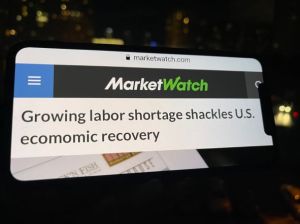As the electronics supply chain lurches from one crisis to the next, global supply lines aren’t faring much better. It’s not just the pandemic that’s disrupted the flow of goods, according to IDC, there’s the specter of cybersecurity, confusion around Brexit, global shipping constraints, inflation and geopolitical risk.
Disruption is the new normal, and businesses are trying to adjust. The tech industry is looking to regionalize semiconductor manufacturing, but the supply chain is likely to remain global. “Even if products are assembled in America, materials and components come from all over the world,” said Simon Ellis, program vice president for IDC Manufacturing Insights. “The supply chain has been globally intertwined for 50 years and I don’t see that being deconstructed.”

New market dynamics are among five trends that IDC said will drive supply chain development over the next decade. In no particular order, they include networks and ecosystems; data analytics and automation; sustainability and the global workforce.
Bring on the cloud
Technology is at the heart of most development. Even with MRP and ERP systems, supply chain partners don’t do a great job communicating with one another. But end-to-end supply chain digitization hasn’t been a priority for many businesses. Supply chain operations and procurement are viewed as cost centers. Ellis and other experts “credit” the unprecedented events of the past two years with advancing supply chain technology.
“Companies are beginning to recognize if their supply chain doesn’t work their business doesn’t work,” Ellis said. Or, as another advisor remarked: “Companies come to us after something has broken.”
IDC points out that supply chain networks and business ecosystems aren’t necessarily the same thing but are intertwined. Networks are a functional subset of the business relationships that make up an ecosystem.
“Networks are about finding ways to connect existing suppliers, so the supply chain is more transparent, and businesses get a better feel for what is available,” explained Ellis. End-to-end visibility, or knowing your suppliers’ suppliers, has gained attention as the global movement of materials and components remains constrained.
IDC identified cloud-based multi-enterprise supply chain networks as the most important technology for improvement. Equally as important is the ability to capture and analyze data. “It certainly is intuitively obvious that supply chains that can act based on data-driven insights will get better results than those that act on seat-of-the-pants–driven insights,” the firm noted.
A significant percentage of supply chain IT spending is on legacy on-premises applications. True SaaS cloud is currently at about 21percent of the SCM market and is expected to grow to 45 percent by 2025, said IDC. This means that for the foreseeable future, supply chains will be using a variety of vendor tools, some in the cloud and other on premises. Connectivity between these systems remains a challenge.
Global dynamics
Onshoring will help reduce IC-supply risk from a geopolitical standpoint, said Ellis. “From a strategic perspective we should have semiconductor manufacturing capacity in the U.S.,” he said. “There’s no better crystal ball pertaining to risk than the trouble with Russia, and it would be no surprise if China is next.”
Ukraine supplies more than 70 percent of world’s neon gas, which is used in chip making, and China is a source of minerals, metals, components, substrates and packaging for the industry.
Materials procurement remains problematic, and end-customers are rarely aware of the front-end of supply networks. “I don’t think anyone truly appreciated the [upstream] supply chain until Russia invaded Ukraine and the world’s supply of neon was affected,” Ellis said. Supply chain visibility should extend all the way to wafer, substrate and materials sourcing. Were China to forcibly annex Taiwan, entire segments of electronics supplies would grind to a halt.
Labor remains scarce and expensive for the tech industry and is a long-term problem. Automation gets a bad rap for eliminating manufacturing jobs but ironically could address the deficiency that has plagued the tech industry for years. “Automation is task replacement, not people replacement,” said Ellis. Moreover, “automation isn’t replacing people you can’t hire anyway. Smart automation makes sense for the supply chain. It’s technology like AI that learns from existing data and doesn’t make business decisions. It’s not ‘Skynet.’”
Sustainability is now a priority for the supply chain and spans several dimensions. The first is the circular economy which gauges a company’s impact on climate and the environment. Then there’s sustainable supply: the long-term viability of vendors, on-hand inventory and dependable logistics. Many electronics companies are designing products based more on component availability than on price or performance.
Sustainability must be part of the way the supply chain is run rather than a CSR initiative, said Ellis. “That means operating with sustainability principals in mind, not just a regulatory or reporting requirements. For example, much of the country is in a drought right now. Companies looking to expand should consider reducing their water usage. If supply chains are entering a protracted period of resource constraints –and there is certainly evidence to suggest that is the case — then sustainable supply will be a critical element of successful companies.”
IDC recommends steps to enhance supply-chain technology:
- Make SCM a “suite” play. End-user organizations favor application integration over marginal functionality with the long-term goal of a single, integrated set of tools that are designed to work together.
- Go public cloud. Within the next five years, new supply chain management purchases will be almost exclusively made on public cloud applications. New capabilities and connectivity are now predominantly within the cloud.
- Improve data quality and integrity. Supply chain planning and fulfillment performance are only as good as the data that informs decisions. In a world of AI-driven automation, bad data will simply mean faster bad decisions.
- Provide seamless integration that translates to seamless execution. Supply chains must be able to deliver anything to anywhere at any time. Seamless integration of information with business processes makes finding goods, matching them with demand and fulfilling an order faster.


